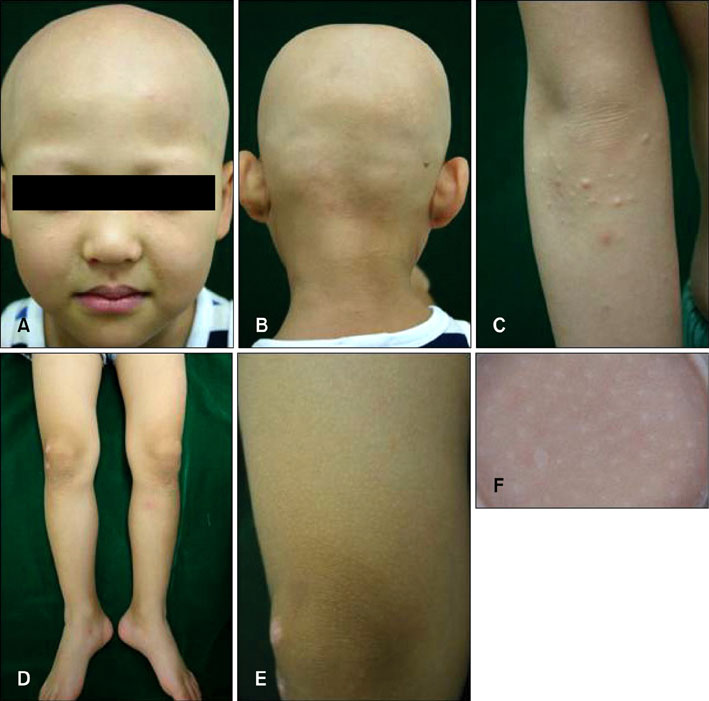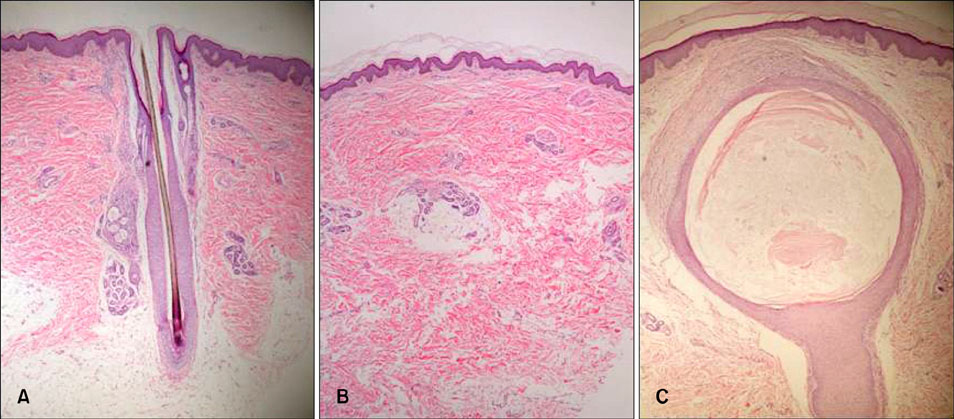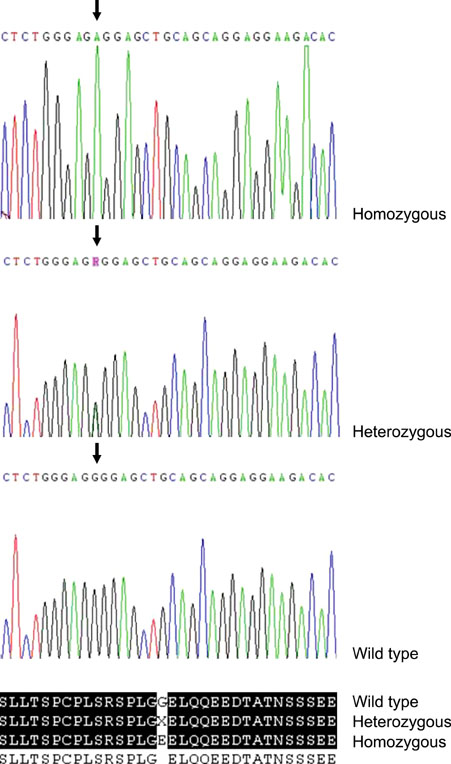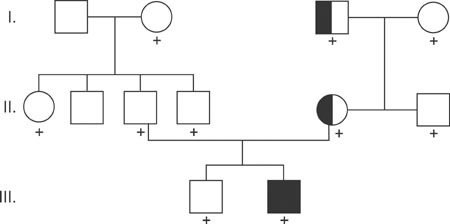Ann Dermatol.
2011 May;23(2):132-137. 10.5021/ad.2011.23.2.132.
Detection of a Novel Missense Mutations in Atrichia with Papular Lesions
- Affiliations
-
- 1Department of Dermatology, Busan Paik Hospital, College of Medicine, Inje University, Busan, Korea. btyouth@hanmail.net
- 2Graduate School of Molecular & Biomedical Technology, Inje University, Gimhae, Korea.
- 3College of General Education, Inje University, Gimhae, Korea.
- 4Ulsan Kang Nam Skin Clinic, Ulsan, Korea.
- 5Dr. Park's Dermatology Clinic, Busan, Korea.
- KMID: 2156652
- DOI: http://doi.org/10.5021/ad.2011.23.2.132
Abstract
- BACKGROUND
Atrichia with papular lesions (APL) is a rare inherited disease characterized by early onset of total hair loss, followed by papular lesions over the extensor areas of the body. Recently, mutations in the human hairless (HR) gene have been implicated in its pathogenesis. The identification of mutations in the HR gene is important for differentiating between APL and alopecia universalis (AU).
OBJECTIVE
We compared the HR genes of patients with presumed AU who showed minimal or no response to treatment with the HR genes of healthy controls.
METHODS
The subjects were 11 patients with presumed AU who had not responded to treatments. Fifty healthy people were included as controls for molecular analysis. To screen for mutations, polymerase chain reaction was performed.
RESULTS
DNA analysis identified a novel heterozygous G-to-A transition at nucleotide position 191 in exon 5. The mutation was not found in the controls, other AU patients, or any unaffected family members except for the patients' mother and maternal grandfather, who were heterozygous HR gene carriers.
CONCLUSION
Our study identifies a novel missense mutation in exon 5 of the HR gene in a Korean APL patient previously diagnosed as AU.
MeSH Terms
Figure
Reference
-
1. Fredrich HC. Zur kenntnis der kongenitale hypotrichosis. Dermatol Wochenschr. 1950. 121:408–410.2. Damste TJ, Prakken JR. Atrichia with papular lesions; a variant of congenital ectodermal dysplasia. Dermatologica. 1954. 108:114–121.
Article3. Loewenthal LJ, Prakken JR. Atrichia with papular lesions. Dermatologica. 1961. 122:85–89.
Article4. Zlotogorski A, Martinez-Mir A, Green J, Lam H, Panteleyev AA, Sinclair R, et al. Evidence for pseudodominant inheritance of atrichia with papular lesions. J Invest Dermatol. 2002. 118:881–886.
Article5. Cichon S, Anker M, Vogt IR, Rohleder H, Pützstück M, Hillmer A, et al. Cloning, genomic organization, alternative transcripts and mutational analysis of the gene responsible for autosomal recessive universal congenital alopecia. Hum Mol Genet. 1998. 7:1671–1679.
Article6. Zlotogorski A, Panteleyev AA, Aita VM, Christiano AM. Clinical and molecular diagnostic criteria of congenital atrichia with papular lesions. J Invest Dermatol. 2002. 118:887–890.
Article7. Indelman M, Bergman R, Lestringant GG, Peer G, Sprecher E. Compound heterozygosity for mutations in the hairless gene causes atrichia with papular lesions. Br J Dermatol. 2003. 148:553–557.
Article8. Paller AS, Varigos G, Metzker A, Bauer RC, Opie J, Martinez-Mir A, et al. Compound heterozygous mutations in the hairless gene in atrichia with papular lesions. J Invest Dermatol. 2003. 121:430–432.
Article9. Henn W, Zlotogorski A, Lam H, Martinez-Mir A, Zaun H, Christiano AM. Atrichia with papular lesions resulting from compound heterozygous mutations in the hairless gene: A lesson for differential diagnosis of alopecia universalis. J Am Acad Dermatol. 2002. 47:519–523.
Article10. Ashoor GG, Greenstein RM, Lam H, Martinez-Mir A, Zlotogorski A, Christiano AM. Novel compound heterozygous nonsense mutations in the hairless gene causing atrichia with papular lesions. J Dermatol Sci. 2005. 40:29–33.
Article11. Yip L, Horev L, Sinclair R, Zlotogorski A. Atrichia with papular lesions: a report of three novel human hairless gene mutations and a revision of diagnostic criteria. Acta Derm Venereol. 2008. 88:346–349.12. Ahmad W, Faiyaz ul Haque M, Brancolini V, Tsou HC, ul Haque S, Lam H, et al. Alopecia universalis associated with a mutation in the human hairless gene. Science. 1998. 279:720–724.
Article13. Panteleyev AA, van der Veen C, Rosenbach T, Muller-Rover S, Sokolov VE, Paus R. Towards defining the pathogenesis of the hairless phenotype. J Invest Dermatol. 1998. 110:902–907.
Article14. Cotsarelis G, Sun TT, Lavker RM. Label-retaining cells reside in the bulge area of pilosebaceous unit: implications for follicular stem cells, hair cycle, and skin carcinogenesis. Cell. 1990. 61:1329–1337.
Article15. Oshima H, Rochat A, Kedzia C, Kobayashi K, Barrandon Y. Morphogenesis and renewal of hair follicles from adult multipotent stem cells. Cell. 2001. 104:233–245.
Article16. Thompson CC, Sisk JM, Beaudoin GM 3rd. Hairless and Wnt signaling: allies in epithelial stem cell differentiation. Cell Cycle. 2006. 5:1913–1917.
Article17. Wang J, Malloy PJ, Feldman D. Interactions of the vitamin D receptor with the corepressor hairless: analysis of hairless mutants in atrichia with papular lesions. J Biol Chem. 2007. 282:25231–25239.18. Panteleyev AA, Paus R, Ahmad W, Sundberg JP, Christiano AM. Molecular and functional aspects of the hairless (HR) gene in laboratory rodents and humans. Exp Dermatol. 1998. 7:249–267.
Article19. McGowan KM, Coulombe PA. Keratin 17 expression in the hard epithelial context of the hair and nail, and its relevance for the pachyonychia congenita phenotype. J Invest Dermatol. 2000. 114:1101–1107.
Article20. Kruse R, Cichon S, Anker M, Hillmer AM, Barros-Nunez P, Cantu JM, et al. Novel hairless mutations in two kindreds with autosomal recessive papular atrichia. J Invest Dermatol. 1999. 113:954–959.21. Zlotogorski A, Hochberg Z, Mirmirani P, Metzker A, Ben-Amitai D, Martinez-Mir A, et al. Clinical and pathologic correlations in genetically distinct forms of atrichia. Arch Dermatol. 2003. 139:1591–1596.
Article22. Ahmad W, Zlotogorski A, Panteleyev AA, Lam H, Ahmad M, Faiyaz ul Haque M, et al. Genomic organization of the human hairless gene (HR) and identification of a mutation underlying congenital atrichia in an Arab Palestinian family. Genomics. 1999. 56:141–148.
Article23. Betz RC, Indelman M, Pforr J, Schreiner F, Bauer R, Bergman R, et al. Identification of mutations in the human hairless gene in two new families with congenital atrichia. Arch Dermatol Res. 2007. 299:157–161.
Article24. Kim H, Wajid M, Kraemer L, Shimomura Y, Christiano AM. Nonsense mutations in the hairless gene underlie APL in five families of Pakistani origin. J Dermatol Sci. 2007. 48:207–211.
Article25. Wali A, Ansar M, Khan MN, Ahmad W. Atrichia with papular lesions resulting from a novel insertion mutation in the human hairless gene. Clin Exp Dermatol. 2006. 31:695–698.
Article
- Full Text Links
- Actions
-
Cited
- CITED
-
- Close
- Share
- Similar articles
-
- A Case of Atrichia with Papular Lesions
- A Novel Mutation in the MBTPS2 Gene Resulting in Ichthyosis Follicularis, Atrichia, and Photophobia Syndrome
- Mutations of p53 Tumor Suppressor Gene in Spontaneous Canine Mammary Tumors
- Two Cases of Congenital Atrichia Associated with the Gastrointestinal Anomaly in Siblings
- A Case of Acral Persistent Papular Mucinosis





